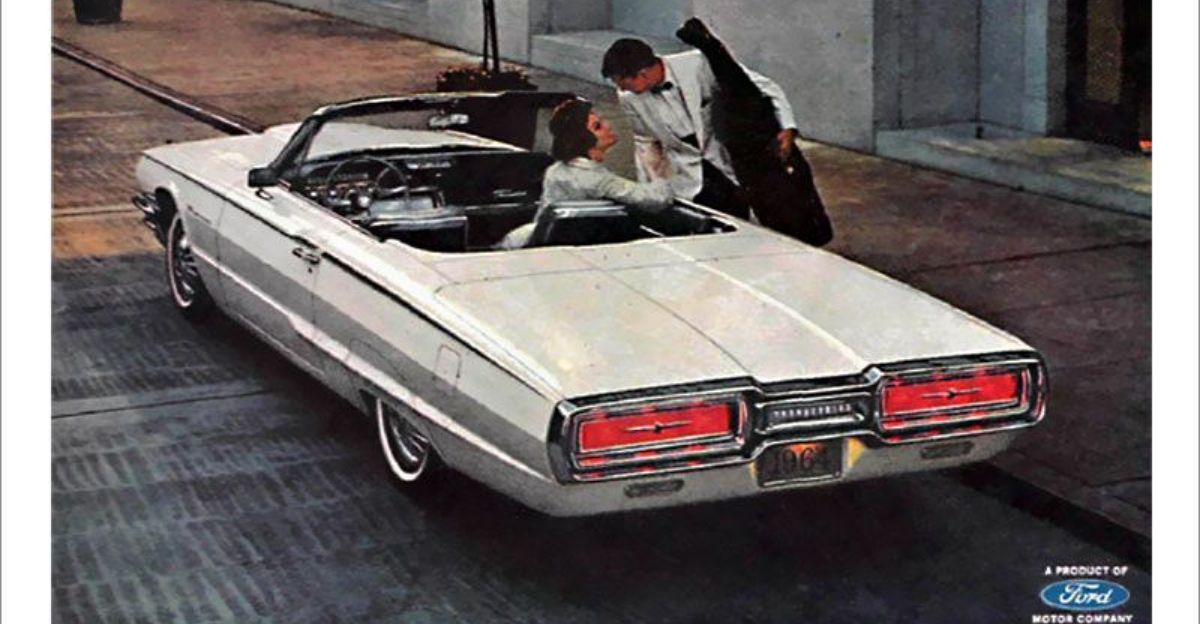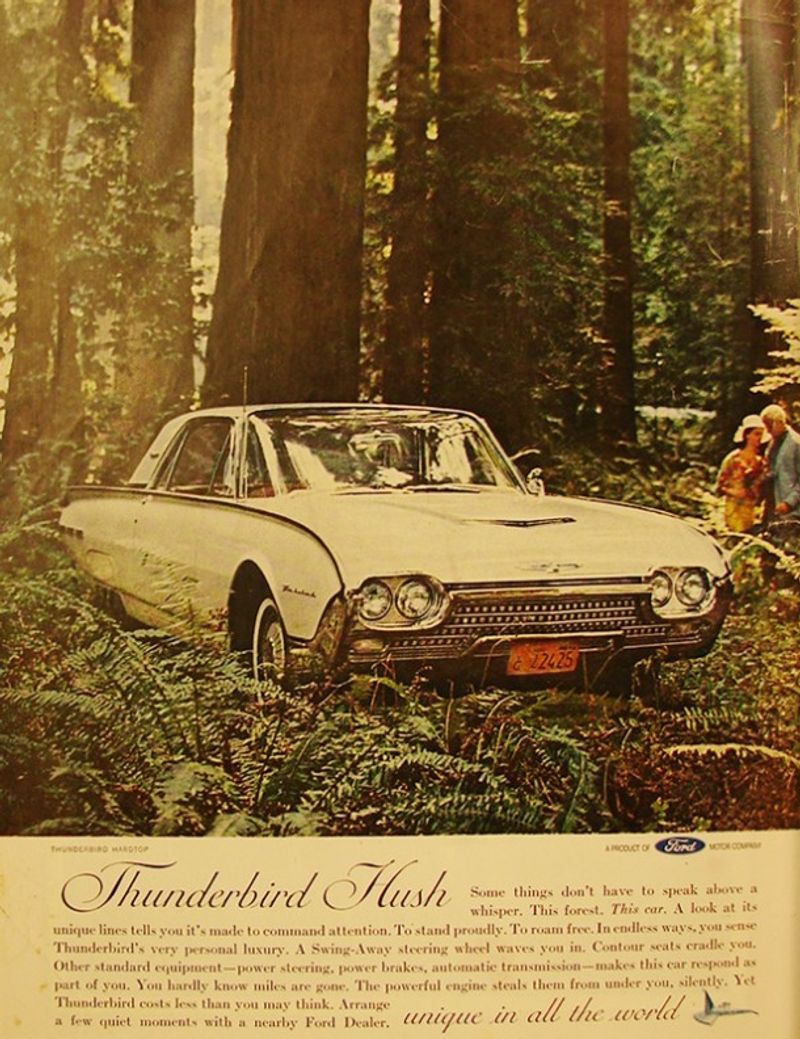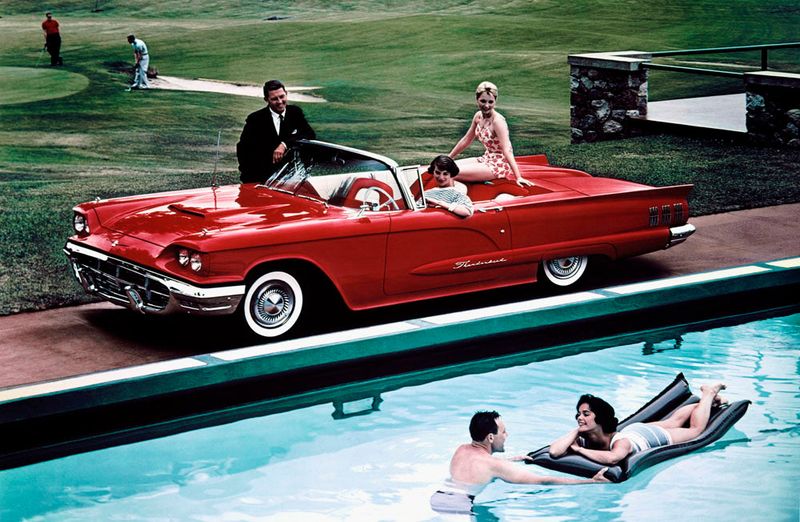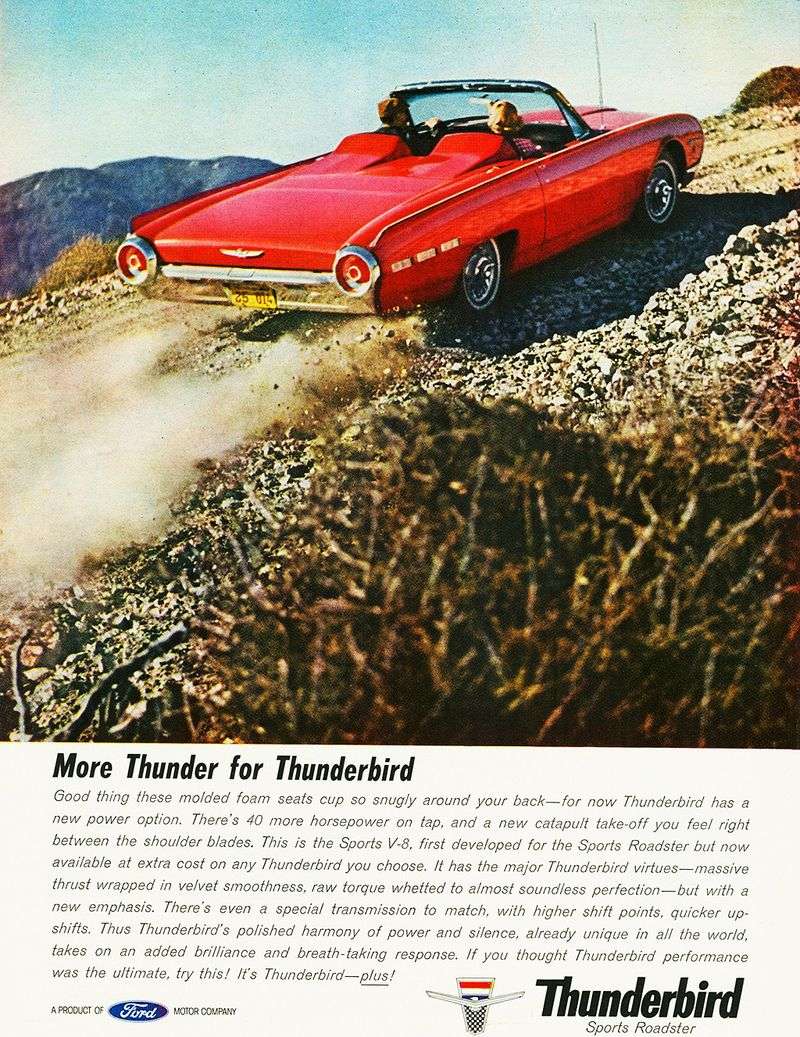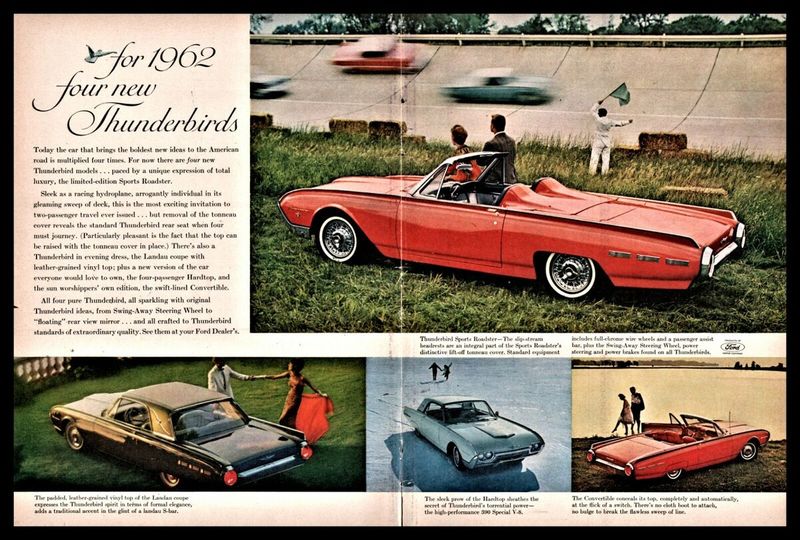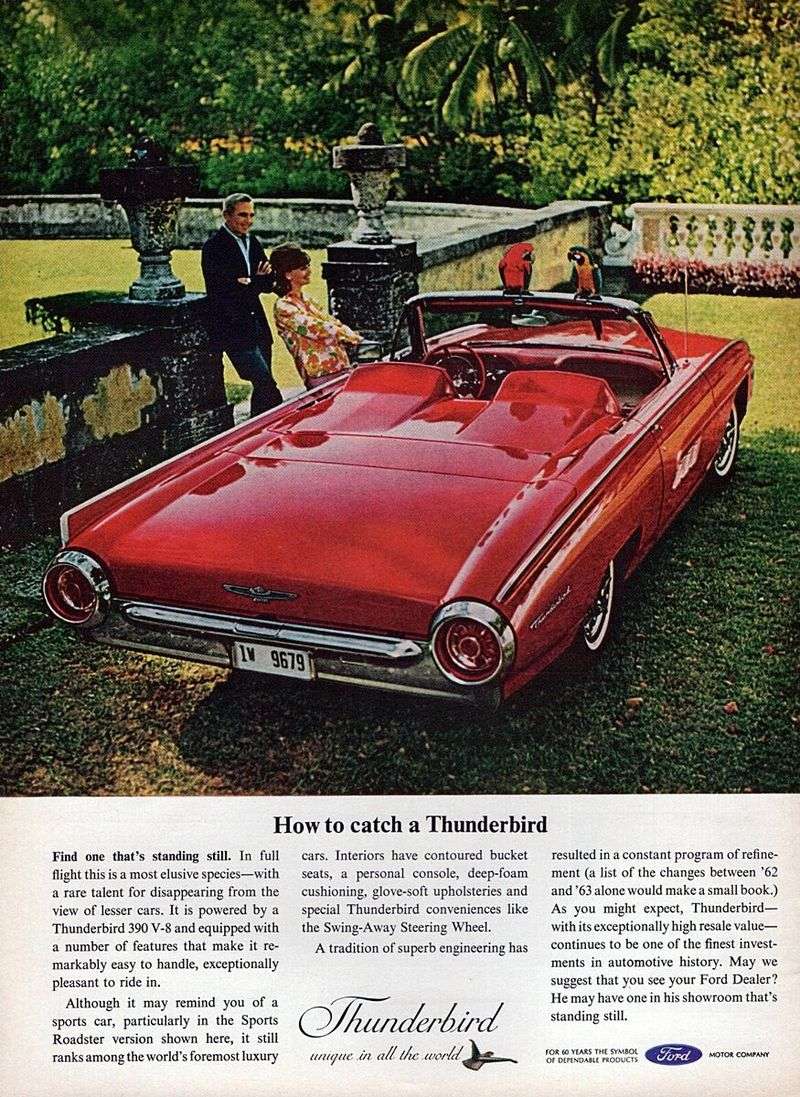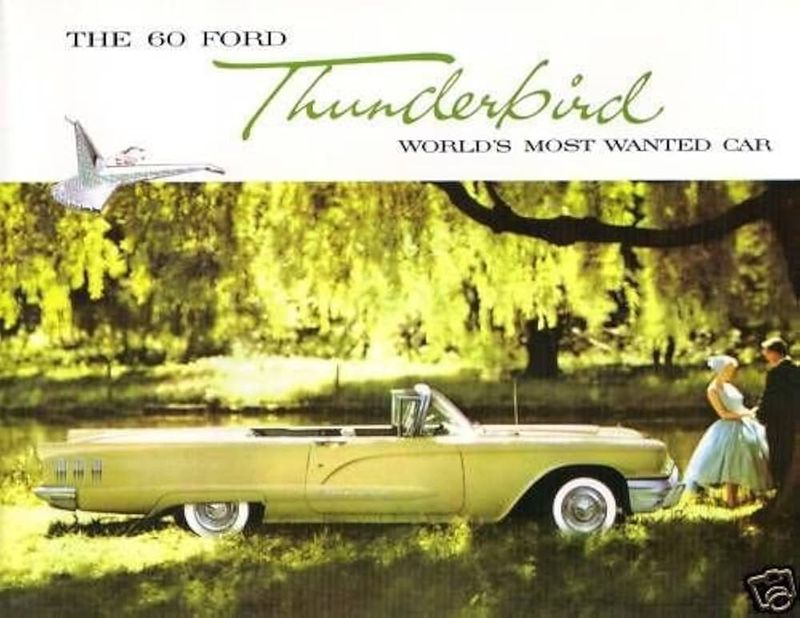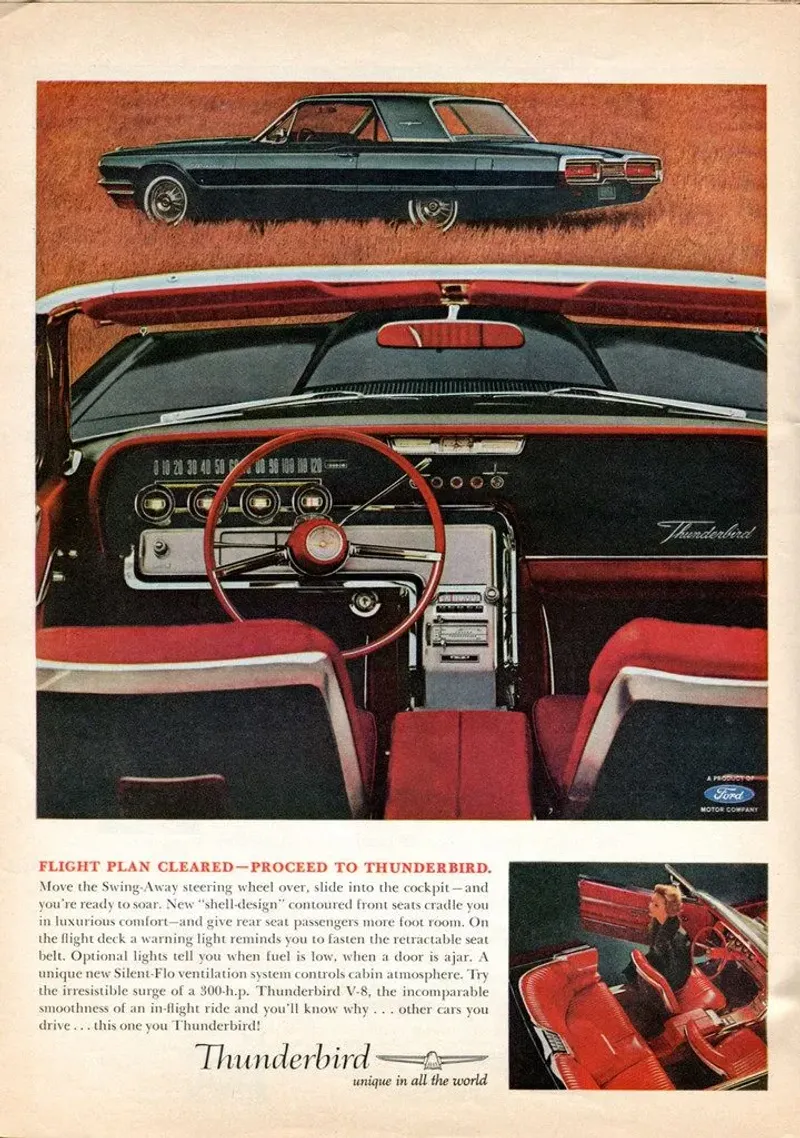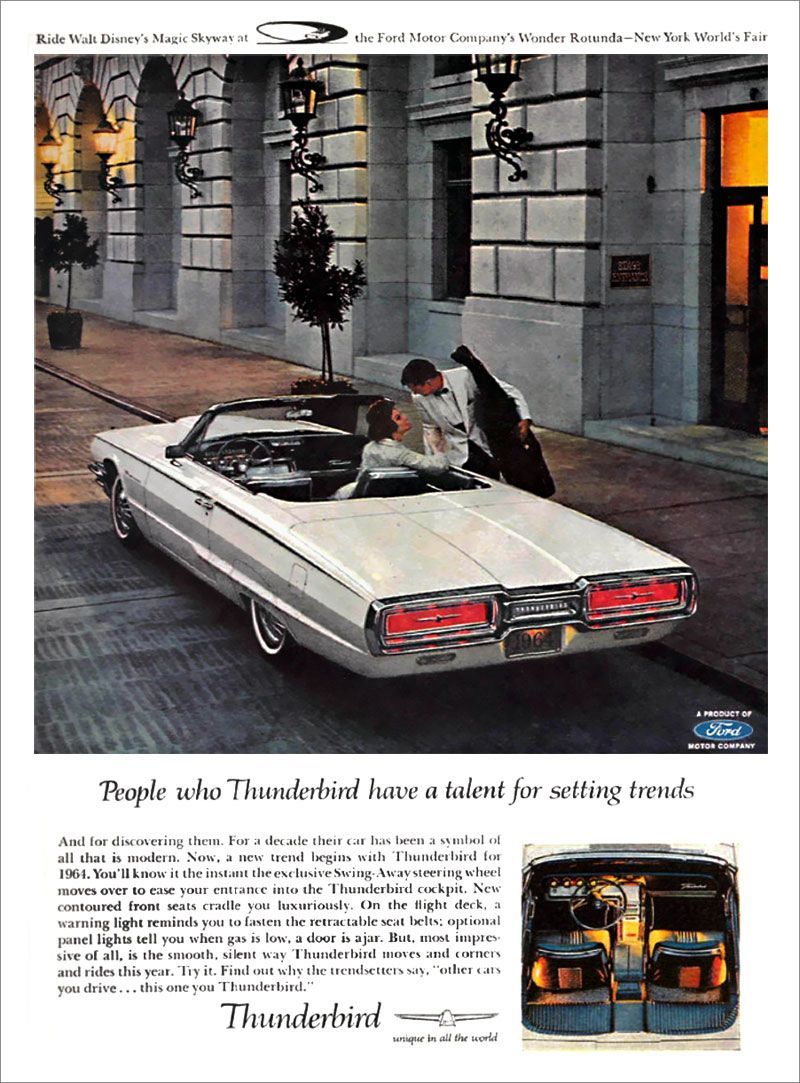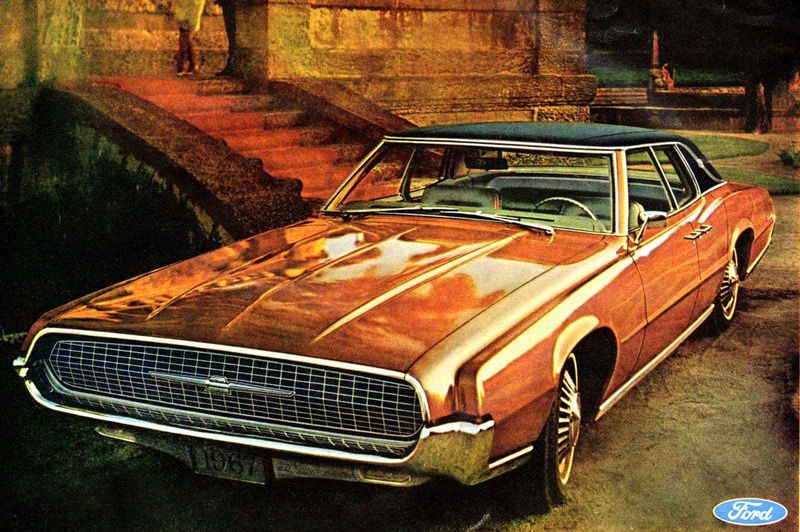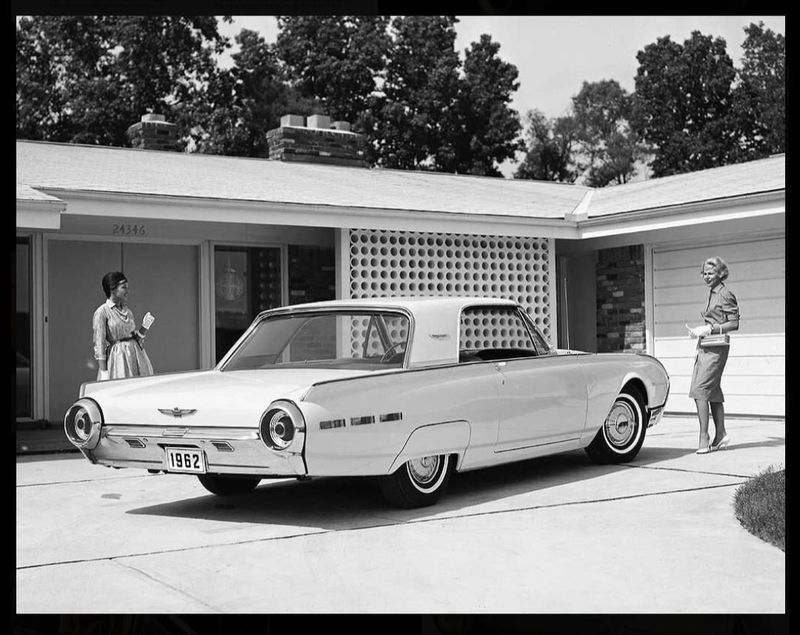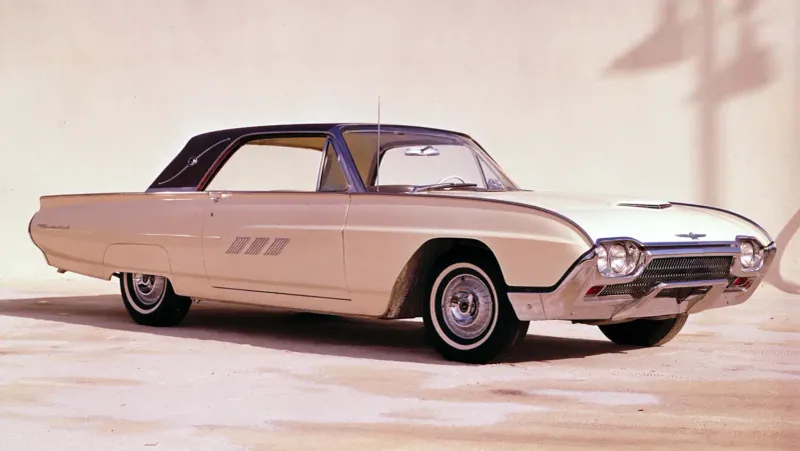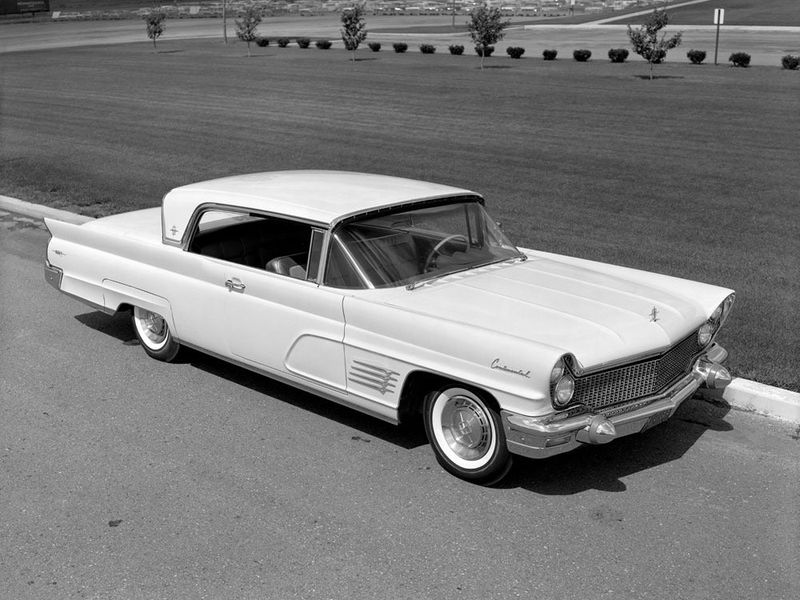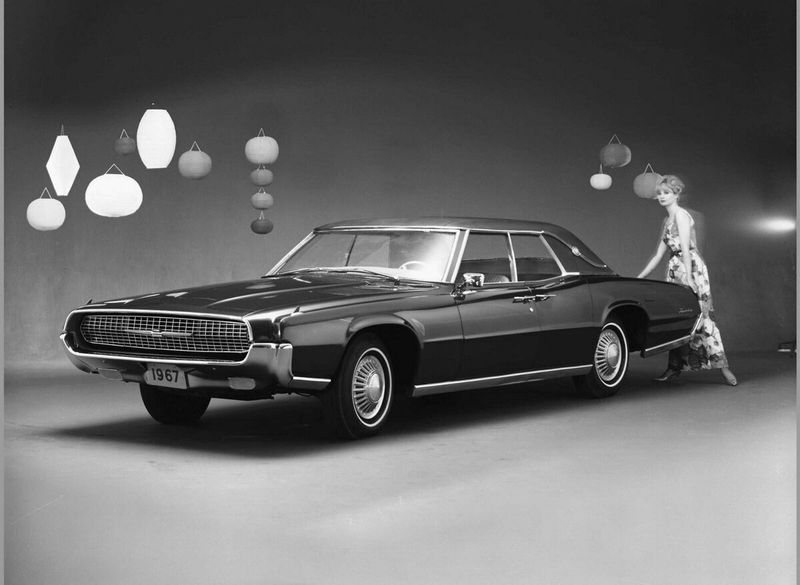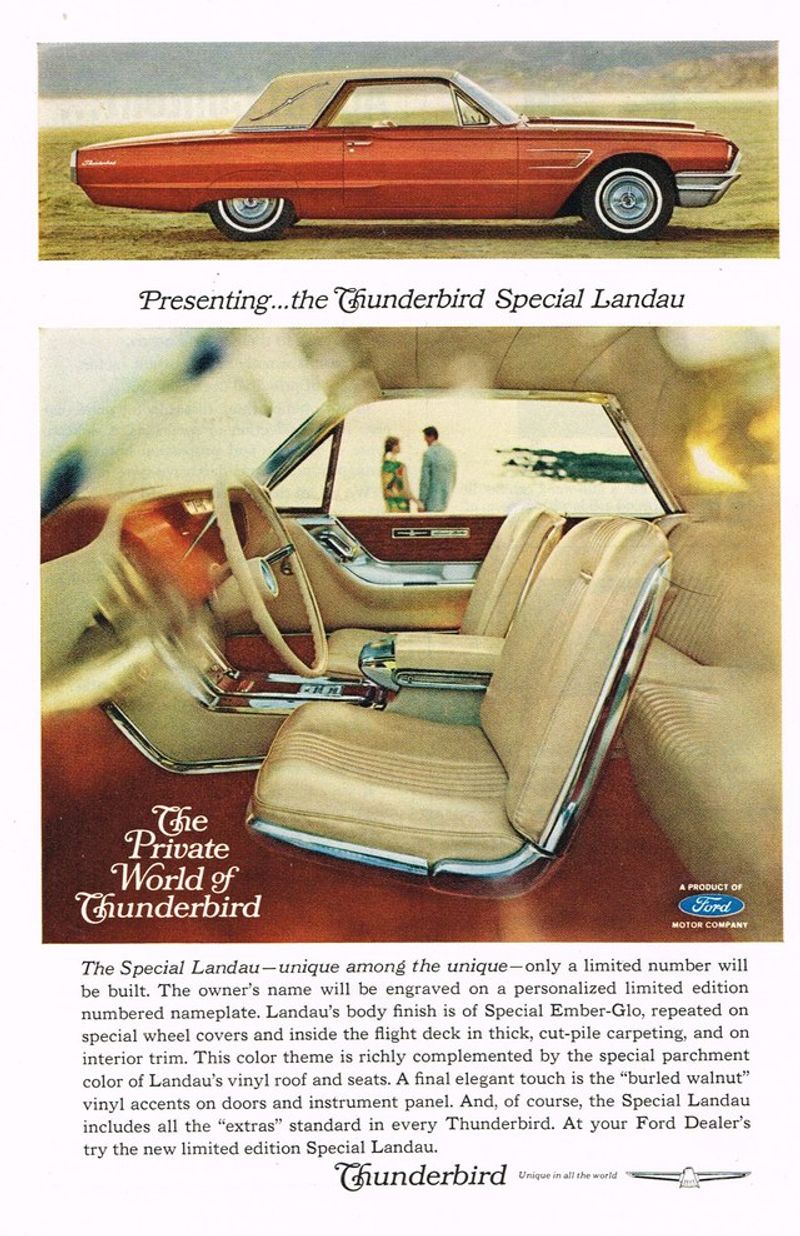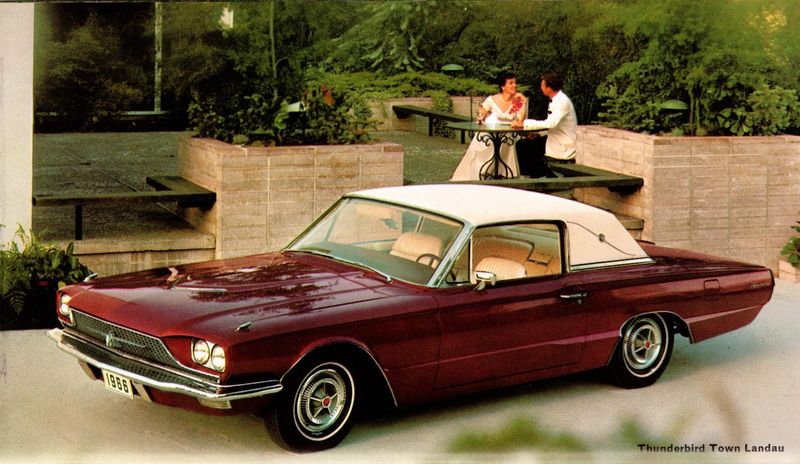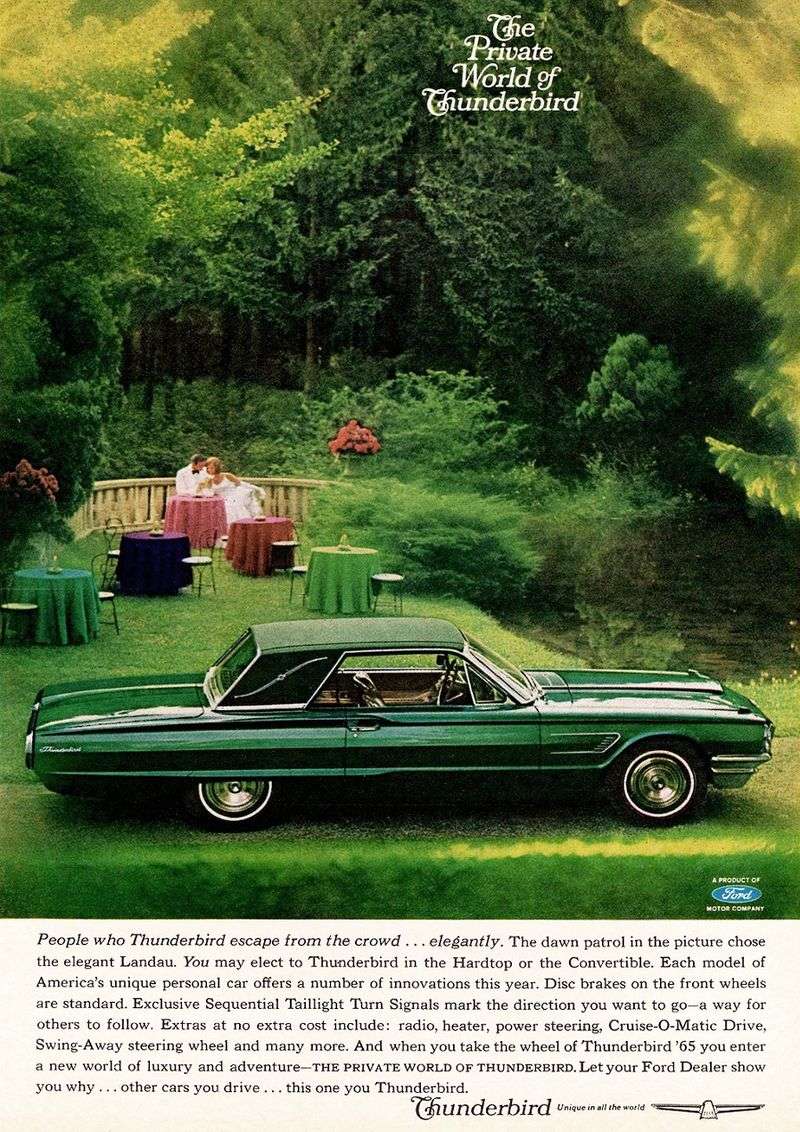In the golden age of American automobiles, few cars turned heads quite like the Ford Thunderbird. By the 1960s, the T-Bird had evolved from a sporty two-seater into a bold symbol of personal luxury—blending power, innovation, and unmistakable style. With sweeping lines, futuristic interiors, and features that were ahead of their time, these cars weren’t just vehicles—they were statements.
In this list, we’re revisiting 20 stunning photos of 1960s Ford Thunderbirds as they first hit the road. But we’re not just here to admire the view—we’re diving into the fascinating facts behind these iconic rides. From presidential parades to hidden design secrets, this is the Thunderbird like you’ve never seen it before.
1. The Thunderbird Wasn’t Always a Luxury Car
When Ford revealed the Thunderbird in 1955, it was a direct competitor to the Corvette. A sleek, sporty roadster, it wasn’t initially seen as a luxury icon. However, by the 1960s, the Thunderbird had evolved, embracing a sophisticated persona that prioritized comfort over raw speed. Leather seats, advanced sound systems, and elegant styling shifted its focus. As the decade progressed, it became synonymous with personal luxury, appealing to those who valued refinement over racing prowess. This transformation illustrates Ford’s ability to pivot and capture the desires of an ever-changing market.
2. 1961 Introduced the Bullet Bird
The third-generation Thunderbird, debuting in 1961, was famously dubbed the ‘Bullet Bird’ due to its pronounced aerodynamic design. Inspired by jet-age aesthetics, its sleek lines and pointed nose reflected the era’s fascination with speed and flight. Advertised as the height of modernity, this model captured imaginations and stood out on the road. Even today, its striking silhouette continues to be admired by enthusiasts and collectors alike. The Bullet Bird’s design showcases a pivotal moment in automotive styling, where form met futuristic function.
3. Thunderbird Was the First with a Swing-Away Steering Wheel
In 1961, the Thunderbird pioneered the swing-away steering wheel, an ingenious innovation enhancing driver convenience. This feature allowed the wheel to slide 18 inches rightward, facilitating easier exits from the low-slung vehicle. Aimed at combining style with practicality, the swing-away wheel was a hit among drivers, especially as the car’s body design emphasized elegance over accessibility. This clever touch not only elevated the driver’s experience but also set a new standard for luxury vehicles, cementing the Thunderbird’s reputation as a trendsetter.
4. Elvis Owned a 1962 Thunderbird
The King of Rock & Roll, Elvis Presley, was known for his flair and taste, and owning a 1962 Thunderbird fit perfectly into his lavish lifestyle. This car, renowned for its power and style, was a favorite of the iconic musician. With its sleek design and throaty engine, the Thunderbird offered the performance and luxury Elvis adored. His ownership of such a vehicle only added to its legendary status, intertwining rock and automotive history. Today, Elvis’s Thunderbird remains a celebrated piece of memorabilia for fans and car enthusiasts.
5. Optional M-Code 390 Engine Was a Beast
In 1962, Ford unveiled the M-code version of the 390 V8 engine for the Thunderbird, a powerhouse with triple two-barrel carburetors that delivered an impressive 340 horsepower. This engine option was not just about speed; it was a statement of engineering prowess. Rare and powerful, the M-code Thunderbirds have become highly sought after by collectors, embodying the muscle car spirit within a luxury framework. Owning one today is a testament to the enduring appeal and impressive technology of 1960s American automotive engineering.
6. The Thunderbird Landau Became a Status Symbol
The 1962 Thunderbird Landau introduced a touch of elegance with its padded vinyl roof and distinctive S-bars. This model quickly became a status symbol among discerning buyers, adding sophistication to the already luxurious Thunderbird line. The Landau’s stylish appearance was more than skin deep; it represented an aspirational lifestyle, appealing to those who sought prestige and refinement. Its unique design elements were both fashionable and functional, making the Landau a memorable model in the Thunderbird’s storied history.
7. The 1963 Thunderbird Had Sequential Turn Signals… Almost
The 1963 Thunderbird came tantalizingly close to introducing sequential turn signals, a feature that would later define the model’s visual identity. Though not implemented until mid-decade, the groundwork was laid during this period. This innovation would have provided a unique, flowing pattern to indicate turns—showcasing the Thunderbird’s forward-thinking approach to design. While the feature didn’t appear until later, its early conception underlines the brand’s commitment to style and safety, blending aesthetics with functionality in a way that would captivate future audiences.
8. T-Birds Were Built Like Tanks
The 1960s Thunderbirds were renowned for their robust construction, weighing in at over 4,500 pounds. Built for straight-line cruising rather than nimble cornering, these vehicles embodied a sense of power and durability. Their substantial build was both a design choice and a statement—ensuring a smooth, comfortable ride on long highway journeys. The T-Bird’s impressive heft offered drivers a sense of security and presence on the road, a quality that made them popular among those who valued substance and style in equal measure.
9. Thunderbird Interiors Were Aviation-Inspired
Stepping inside a 1960s Thunderbird was like entering the cockpit of a jet. The aviation-inspired interiors featured wraparound dashboards, toggle switches, and deep-set gauges, creating an atmosphere of sophistication and control. These design choices reflected the era’s fascination with space and flight, transporting drivers into a world where automotive and aerospace dreams intertwined. The attention to detail in these interiors not only enhanced driver experience but also set the Thunderbird apart as a leader in innovative, stylish design.
10. The 1964 Redesign Was a Game Changer
With its 1964 redesign, the Thunderbird shifted to a bold, squared-off look that was impossible to ignore. This new aesthetic emphasized a wider and lower stance, projecting strength and elegance on the road. It was a departure from the softer lines of previous models, offering a commanding presence that appealed to the 1960s desire for modernity. The redesign didn’t just change the car’s appearance; it redefined what a personal luxury vehicle could be, captivating the market and setting a new standard for style and sophistication.
11. 1964 Introduced Hidden Swing-Away Steering Column Lock
The 1964 Thunderbird introduced a novel safety feature: the locking swing-away steering column. Building on the earlier innovation, this mechanism provided additional security by deterring theft—a rare consideration at the time. It exemplified Ford’s commitment to integrating convenience with cutting-edge technology, enhancing driver peace of mind without compromising the vehicle’s sleek design. This feature underscored the Thunderbird’s reputation for innovation, blending style with practical advancements that appealed to savvy consumers seeking both luxury and security.
12. Luxury Features Came Standard
In a groundbreaking move, the 1960s Thunderbird models offered luxury features as standard, including power windows, power seats, and premium sound systems. These amenities were revolutionary, setting a new benchmark for what drivers could expect in a personal luxury car. The Thunderbird was no longer just about aesthetics; it was about providing an unparalleled driving experience. This commitment to luxury without compromise attracted a discerning clientele, eager to enjoy the finer things in life during their travels.
13. The Thunderbird Landau Became a Presidential Ride
In a testament to its prestige, a custom 1961 Thunderbird Landau was chosen for President John F. Kennedy’s inaugural parade. This honor highlighted the car’s status as a symbol of American luxury and style. The Landau’s sophisticated design and elegance made it a fitting choice for such a significant occasion, solidifying its reputation as a vehicle worthy of national attention. The use of the Thunderbird in this context added a layer of historical significance, intertwining automotive excellence with presidential history.
14. Ford Built a T-Bird Town Car Prototype
In 1963, Ford experimented with the Thunderbird’s potential by crafting a unique ‘Town Car’ prototype. This one-of-a-kind vehicle featured a limousine-style rear cabin and a vinyl-covered roof, blending opulence with innovation. Though it never went into production, the prototype demonstrated Ford’s willingness to explore luxury boundaries, offering a glimpse into a world of bespoke automotive elegance. This daring concept car attracted attention and admiration, highlighting the Thunderbird’s versatility and Ford’s commitment to pushing design limits.
15. The T-Bird Influenced the Lincoln Continental
The influence of the Thunderbird extended beyond its own line, impacting the Lincoln Continental’s development. Ford’s engineers shared platforms and innovative ideas, facilitating cross-brand collaboration that benefited both models. The refined luxury and styling seen in the early 1960s Continentals can be traced back to the Thunderbird’s pioneering designs. This synergy between brands exemplifies how shared knowledge and creativity can lead to exceptional results, showcasing the Thunderbird’s lasting impact on the broader automotive landscape.
16. Thunderbirds Had Retractable Antennas Before It Was Cool
Long before it became a common feature, the 1960s Thunderbird boasted a retractable antenna that extended when the radio was activated. This subtle yet sophisticated touch exemplified the forward-thinking design of the era, adding a layer of modernity to the car’s already impressive feature set. The retractable antenna wasn’t just about aesthetics; it offered practical benefits by reducing damage risks and enhancing the vehicle’s sleek silhouette when not in use, cementing the Thunderbird’s reputation as an innovator in luxury.
17. Ford Offered a Roadster Package with Tonneau Cover
The Thunderbird’s Sports Roadster package, featuring a sleek tonneau cover, offered a unique twist on personal luxury by transforming the car into a two-seater. This fiberglass cover replaced the back seat, giving the vehicle a streamlined, sporty appearance that turned heads wherever it went. This option appealed to those seeking exclusivity and style, blending performance aesthetics with the Thunderbird’s luxurious reputation. The roadster package remains a rare and cherished option among collectors, embodying the adventurous spirit of the 1960s.
18. Disc Brakes Became Available in 1965
Safety and performance came together in 1965 when the Thunderbird introduced front disc brakes, significantly enhancing stopping power. This advancement was a major step forward for a vehicle of such size and weight, ensuring safer journeys for drivers and passengers. The adoption of disc brakes marked the Thunderbird’s commitment to innovation, balancing luxury with cutting-edge engineering. This feature quickly became an industry standard, reflecting the Thunderbird’s role in pioneering automotive safety technologies that would benefit all drivers.
19. 1966 Was the Last Convertible for Years
The 1966 Thunderbird convertible marked the end of an era, as it was the last of its kind until the model’s revival in the late 2000s. This final convertible edition became especially prized among collectors, symbolizing a time when open-air driving was synonymous with freedom and style. The decision to discontinue the convertible option reflected shifting market trends, but it also elevated the 1966 model’s desirability. Today, owning a ’66 Thunderbird convertible is like holding a piece of automotive history, cherished for its elegance and nostalgia.
20. They Weren’t Built to Be Rare—But Many Are Now
While 1960s Thunderbirds were produced in large numbers, many have been lost to time, rust, and attrition, making surviving examples rare and special. Those that remain, especially in original condition, are highly sought after by collectors and enthusiasts. This scarcity adds allure and challenge to acquiring a classic Thunderbird, underscoring the impact of time on these once-common luxury vehicles. The Thunderbird’s journey from mass production to prized collectible reflects its enduring appeal and the timeless allure of classic car restoration.
